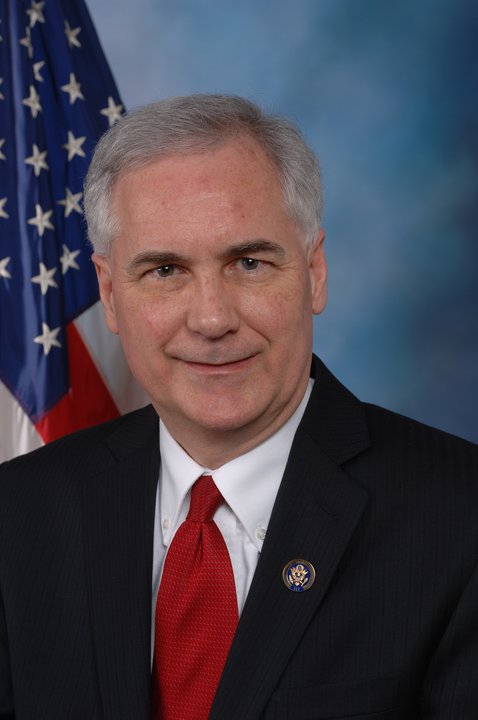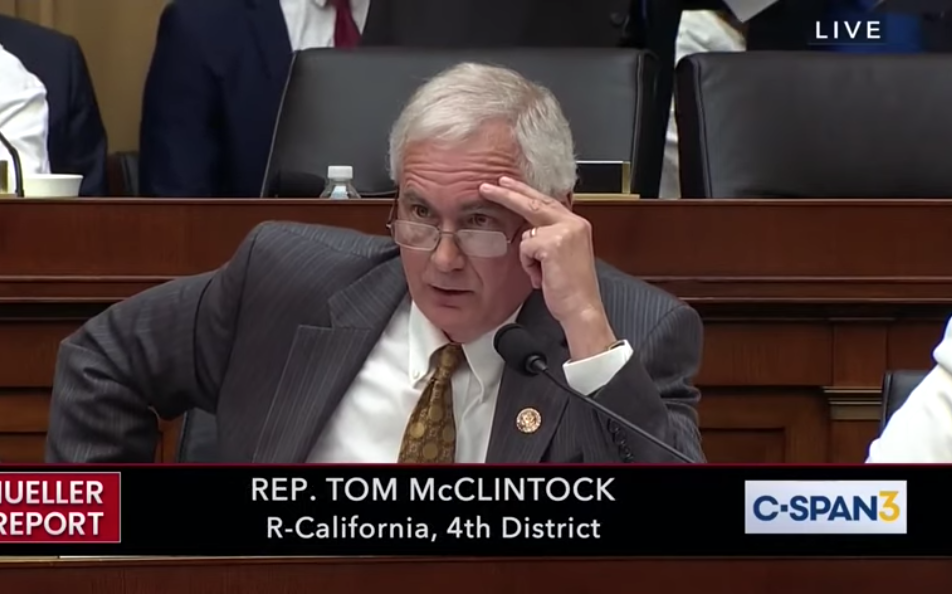
Rep. Tom McClintock. (Photo: McClintock for Congress)
A Fireside Chat with Congressman Tom McClintock After Reelection to CA-4
No, Placer County is not turning blue
By Katy Grimes, November 17, 2020 1:37 pm
Republican California Congressman Tom McClintock may be used to running for reelection, having been elected and reelected to Congress since 2009.
California’s 4th Congressional District is one of the largest, most expansive districts in the state, extending from the North Lake Tahoe region down to the lower Eastern Sierras in the Sequoia National Forest. 4th District counties include Alpine, Amador, Calaveras, El Dorado, Mariposa, and Tuolumne counties — plus portions of Nevada, Fresno, Madera, and Placer counties.
California Globe had a nearly two-hour “fireside chat” with Rep. McClintock Thursday in his District office in Roseville, CA (no fireplace, no whiskey), as he covered many issues important to his district, all California residents, as well as the national election.
Though McClintock’s campaign was once again overwhelmingly outspent, his consistent message that “Freedom Works” resonated throughout the Sierra Nevada district. His 2020 challenger was Brynne Kennedy, who he beat, 55.2% to 44.8%.
The media repeatedly claimed Placer County was turning blue, but it was based on reports of early Democrat votes. “Bless the Republicans for voting on or close to Election Day,” McClintock said.
As the Globe recently reported, after a visit to the Sacramento County Elections Office, the Registrar explained the mail-in ballots and early voting ballots are processed and tabulated up to Election Day. At 8:00PM on Election Day, those totals are what is released. It isn’t until after Election Day that same-day votes are added in to the totals.
“CNN and ABC called the race Election Night,” McClintock said. “It wasn’t until Monday afternoon that FOX and the AP acknowledged my 10 point lead – three days after my opponent conceded!”
We discussed the many opponents Rep. McClintock has faced since 2009; nearly all of them moved in to the district to run against him, including Jessica Moore in 2018, and Kennedy in 2020, and then leave the state once they lose the election.
It’s not that McClintock expects to always win, it is more about the Democrats who truly don’t understand him and his consistent message that “Freedom Works.” And unlike many of his Democrat colleagues in Congress, he always has to mount a reelection campaign and fight as if his life and the people’s lives in his district depend on him winning… because McClintock is focused on the needs of his district.
A brief discussion about the election, legal challenges in seven states and allegations that the election was riddled with fraud cannot be ignored. McClintock said this is because so many safeguards built into our system have been removed, and Election Day is no longer. “We call it “Election DAY,” for a reason he said. “Until recently, we all waited until the campaigns were over and every candidate had their say.”
We spoke extensively about the wildfires in California. McClintock is nothing if not an expert on this issue, as we have reported for many years of wildfire season. The Sierra Nevada of California is in his district, as are Yosemite Valley, Sequoia and Kings Canyon, and Lake Tahoe.
McClintock explained that total federal lands has grown to 640 million acres – 28 percent of the land area in the nation. He also said it owns 46 percent of California – and 93 percent of Alpine County in his district. And in these regions, what used to be well-maintained forests have become choked and unhealthy.
“For decades, traditional forest management was scientific and successful—that is until ideological, preservationist zealots wormed their way into government and began the overhaul of sound federal forest management through abuse of the Endangered Species Act and the ‘re-wilding, no-use movement,” he said.
McClintock said President Donald Trump overrode the bureaucrats at FEMA to begin again to manage federal forest lands. “Our forests are morbidly overgrown,” he said. “Trees are under enormous strain and unhealthy. Bark beetles can’t kill a healthy tree.”
McClintock summarized the series of policy mistakes that are destroying California’s forests. “Our forests are now catastrophically overgrown, often carrying four times the number of trees the land can support. In this stressed and weakened condition, our forests are easy prey for drought, disease, pestilence and fire.”
Today, only privately managed forests are maintained through the traditional forest management practices: thinning, cutting, clearing, prescribed burns, and the disposal of the resulting woody waste.
And private lands do not suffer the wildfires the rest of the state does.
“The governor says climate change is causing wildfires,” McClintock said. Yet the same climate change impacts private lands as public lands, but private forests are not burning down because they are properly managed. Or if a fire does break out on privately managed forest land, it is often extinguished more quickly and easily because the trees aren’t so close together, and the underbrush has been cleared away.”
“You can literally tell the boundary line between public lands and private lands,” McClintock said.
“Excess timber comes out of the forest in only two ways – it is either carried out or it burns out,” McClintock says. “For most of the 20th Century, we carried it out. It’s called ‘logging.’ Every year, U.S. Forest Service foresters would mark off excess timber and then we auctioned it off to lumber companies who paid us to remove it, funding both local communities and the forest service. We auctioned grazing contracts on our grasslands. The result: healthy forests, fewer fires and a thriving economy.”
However, as McClintock explained, “in the 1970’s, we began imposing environmental laws that have made the management of our lands all but impossible. Draconian restrictions on logging, grazing, prescribed burns and herbicide use on public lands have made modern land management endlessly time consuming and ultimately cost prohibitive. A single tree thinning plan typically takes four years and more than 800 pages of analysis. The costs of this process exceed the value of timber – turning land maintenance from a revenue-generating activity to a revenue-consuming one.”
McClintock was able to pass legislation in 2018, which streamlined the environmental reviews, but only for the Tahoe Basin, thus far. McClintock said the Forest Service regional manager told him that it took their review from 800 pages to 40 pages, four years to four months, and allowed them to begin to get the forest back to a sustainable level.
Next: Budget, budget and even more important budget issues
- Leaving California: Three More Major Businesses Close or Move Out of State - December 22, 2025
- Gov. Gavin Newsom’s ‘Great Leap Forward’ – DEI and Reparations Agriculture Land Seizure Scheme - December 22, 2025
- AG Bonta Promotes California’s ‘Migrant Community’ Over California Citizens - December 20, 2025





Thank you for this, Katy Grimes. Always more than glad to hear what Tom McClintock has to say. He’s the best. Hopeful and sensible and informative. Aahh, what a pleasure (and a relief) to have such a congressman in California. Appreciate so much all he has done for us. Also enjoyed very much the relaxed “fireside chat” setting that covered so much ground.
The man who should have been governor when we booted Gray Davis out, if only?
Oh YES. If only.
Can I just say, McClintock as the prettiest Congressional District in the Country. Seriously, California’s natural geography is unparalleled. I love this state sometimes
He should be elected Governor when we RECALL NEWSOM THE CLOWN